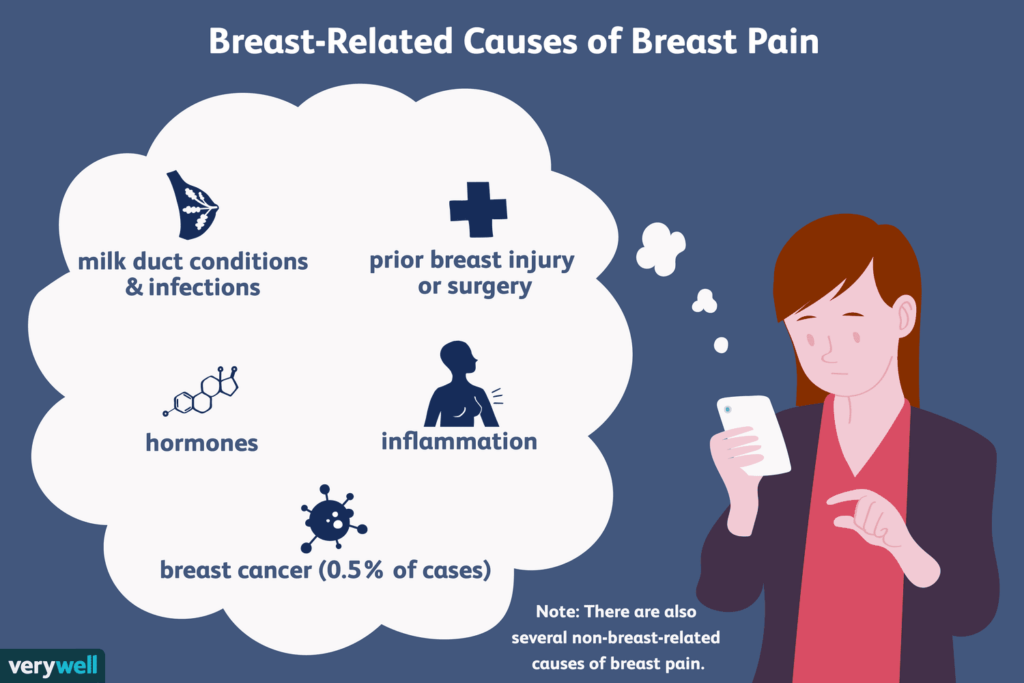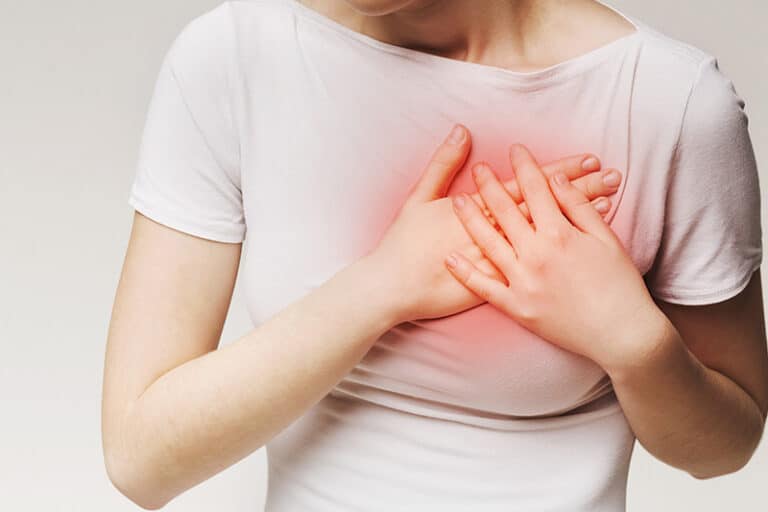Breast pain (mastalgia) is a common experience among many individuals, characterized by discomfort, tenderness, or a sharp sensation in the breast or underarm region. While it’s natural to worry about breast cancer when experiencing breast pain, the good news is that breast pain is rarely a sign of cancer. This guide will help you understand the various causes of breast pain, when to seek medical advice, and how to manage it effectively.
Common Causes of Breast Pain

Breast pain can arise from a variety of factors, many of which are benign and temporary. Here are the most common causes:
1. Hormonal Changes
Hormonal fluctuations are the leading cause of breast pain, particularly during:
- Menstrual cycles: Many experience pain three to five days before their period due to rising estrogen and progesterone levels.
- Pregnancy: Breast tenderness often occurs in the first trimester as hormones ramp up.
- Menopause: Changes in hormone levels can also cause intermittent breast pain.
2. Fibrocystic Breast Tissue
- Description: Fibrocystic breast tissue contains lumps and fluid-filled cysts that can be more sensitive before menstruation.
- Note: This is a benign condition unrelated to breast cancer.
3. Breastfeeding
- Causes:
- Improper latching or positioning.
- Engorgement (overfull breasts).
- Mastitis (an infection in the milk ducts).
- Solution: Addressing latch issues and, if necessary, seeking antibiotics for mastitis can alleviate pain.
4. Breast Injury
Injuries from accidents, sports, or surgeries can result in pain or tenderness. Symptoms may linger for days or weeks.
5. Ill-Fitting Bras
An unsupportive bra can strain the ligaments and muscles, leading to soreness, especially during physical activity.
6. Medications
Certain medications list breast pain as a side effect, including:
- Antidepressants like SSRIs.
- Diuretics.
- Hormone replacement therapies.
7. Infections
Non-lactating individuals can also experience infections, often leading to:
- Localized redness and warmth.
- Swelling and fever.
8. Cysts and Lumps
- Benign Cysts: Fluid-filled sacs that can be tender but are non-cancerous.
- Cancerous Lumps: Rarely painful but should be evaluated if accompanied by other symptoms.
When Breast Pain Might Indicate Cancer
Although breast pain is rarely a symptom of cancer, certain forms of breast cancer, such as inflammatory breast cancer, may present with pain. Key warning signs include:
- Persistent, unexplained pain in one breast.
- Redness, dimpling, or a rash resembling orange peel texture (peau d’orange).
- A lump or thickened area that doesn’t resolve after your menstrual cycle.
If you experience pain along with the following, consult your doctor immediately:
- Bloody or clear nipple discharge.
- A new, persistent lump.
- Symptoms of infection, such as pus or fever.
Types of Breast Pain
1. Cyclical Breast Pain
- Related to the menstrual cycle and subsides afterward.
- Often bilateral (affects both breasts).
- Managed with OTC pain relievers and lifestyle changes like reducing caffeine and salt intake.
2. Non-Cyclical Breast Pain
- Not tied to hormones.
- Can result from injuries, infections, or cysts.
3. Extramammary Pain
- Originates from muscles or tissues near the breast, such as chest wall injuries or rib inflammation.
Managing Breast Pain
Lifestyle Changes
- Supportive Bras: Wear a well-fitted bra, especially during exercise.
- Dietary Adjustments: Reduce caffeine, salt, and fat intake.
- Cold/Heat Therapy: Apply ice packs or warm compresses to alleviate discomfort.
Medical Options
- OTC Pain Relievers: Ibuprofen or acetaminophen can reduce inflammation and pain.
- Hormonal Adjustments: For persistent pain, your doctor may recommend altering birth control or hormone replacement therapies.
Home Remedies
- Practice gentle massage with warm oil.
- Avoid tight clothing that might increase discomfort.
Breast Pain in Males
Although rare, males can experience breast pain due to:
- Gynecomastia: Hormonal imbalances leading to breast tissue enlargement.
- Breast Cancer: Though uncommon, lumps or changes in male breast tissue warrant immediate medical attention.
When to See a Doctor
Consult a healthcare provider if you experience:
- Persistent pain lasting over two weeks.
- Pain in one breast accompanied by swelling or redness.
- A lump or thickened area that doesn’t go away.
- Nipple discharge or inversion.
- Pain interfering with daily life.
FAQs
1. Is breast pain always a sign of cancer?
No, breast pain is usually linked to benign conditions like hormonal changes, fibrocystic tissue, or injury.
2. What does cancer-related breast pain feel like?
It is typically gradual and may present with redness, swelling, or thickened skin. Cancerous lumps, however, are usually painless.
3. Can men experience breast pain?
Yes, men can experience breast pain from conditions like gynecomastia or, less commonly, male breast cancer.
Summary
While breast pain is usually harmless and linked to hormonal changes or benign conditions, it’s important to stay vigilant and consult a doctor if the pain persists or is accompanied by other concerning symptoms. Early detection through routine self-exams and mammograms remains critical for addressing breast health concerns.
References
- American Cancer Society
- Breast Cancer Signs and Symptoms: www.cancer.org
- National Breast Cancer Foundation
- Understanding Breast Pain: www.nationalbreastcancer.org
- Mayo Clinic
- Causes and Management of Breast Pain: www.mayoclinic.org
- Centers for Disease Control and Prevention (CDC)
- Breast Health and Awareness: www.cdc.gov
By being proactive and informed about breast pain, you can ensure better management and peace of mind. Always prioritize your health and seek medical advice for persistent or unusual symptoms!


